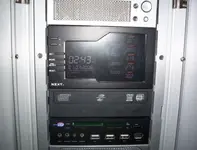Cubfan64 said:
Springfield said:
Cubfan64 said:
....
There have been MANY times I've been involved in analyzing things in the lab where those of us doing the work don't interpret the results the same way.
And in each instance I assume there was a report prepared containing procedures used, data collected, personnel involved and conclusions summarized.
Yes, whether there is a customer involved for the work or if it's just an internal analysis/investigation of something there is always documentation.
That said, it's just as political as any other place. If the analysts involved don't necessarily agree on the interpretation of the results, eventually SOMEONE has to make a decision FOR THE LAB. Sometimes the customer is given all the possibilities/interpretations as options to what the "lab" believes, and sometimes the person in charge of the project doesn't share all that with the customer and just goes with the interpretation of who he feels is the most "trusted" analyst - heck, sometimes they even give the interpretation THEY feel is the most correct even though they did none of the testing.
That's why, to be honest with you all, Bob's statement about what the FBI agent said to him doesn't really answer any questions definitively, and without documentation from the FBI's analysis, there's no way to interpret the answer to Bob's question of him.
Paul,
I have worked in a lab and done quite a few evaluations which required written reports myself. Although very different from an evaluation of the stones, the requirements for documentation of the results of the evaluation could be much the same.
In my case I worked in a radiation survey instrument calibration lab. Not often, but occasionally an individual would be working in a radiologicaly controlled area, and receive an accumulated exposure (of radiation for a specific and identified time in the area), greater than had been anticipated, based on a documented radiation survey of the area prior to the work being performed. This type of an event would always be followed up with an examination of the survey instrument.
The serial number of survey instrument used to perform all surveys is always shown on the survey form. When circumstances like the one described above occur, the instrument would always be sent to the lab to determine it's current state of accuracy. Normally it was a simple matter of exposing it to the variety of known radiation fields it is calibrated to and documenting it’s responses in terms of +/- % error. Normally anything that responds to within +/- 10 % of all of the known fields exposed to, is considered to be within acceptable limits and in calibration.
That’s under normal circumstances. Every now and then a situation occurs where the instrument in question has been dropped or otherwise damaged since the radiation survey in question was performed, and it cannot be checked for it’s current state of calibration, or even if it was still functional, the results of the test would be inconclusive, as far as what state of calibration it was in when the survey was performed.
In a case like that. The only thing that could be documented was that an evaluation could not be performed and the reason stated. A copy of the most recent calibration data sheet would be attached to the report, to indicate it’s status the last time it left the calibration lab, and the file would be closed. “Inconclusive”
In the case of the FBI investigation of the stone maps, things become a lot more complicated, and a lot less scientific. The only thing I can think of that they could have used to estimate the age of he carvings on the maps back in the 60’s would have been an examination of any residual patina deep within the groves. (since nobody at the time thought about the glue in the repaired heart stone)
Although an evaluation of “patina” could be a fair estimate of age, it is not, in most cases, considered to be an “exact science”. It is very possible that the FBI investigation and resulting “opinion” of the age of the maps, was based what they saw in the way of patina, but because of the possibility of pending litigation and scrutiny of their “opinion” by the Defendant’s Attorney in court. They opted not to put their “opinion” in writing in a formal report,
unless specifically asked to do so, (which may never have happened) but "IF" requested, would have included a lot of “wiggle room” with an allowed tolerance of +/- an accuracy of somewhere around 100 years. Which is what they more or less stated verbally.
Under the circumstances I see every possibility that no formal report was ever written up, depending on what FBI procedures of the time required. What good would a report stamped "inconclusive" to within +/- 100 years have been to either side?
Best,
Jim










